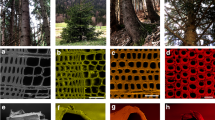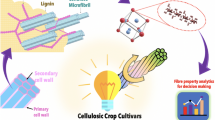Abstract
Lignocellulosic fibres harvested from different plant types exhibit variations in mechanical properties that are associated with their chemical composition and physical features. This diversity indicates that plant fibres could be selected based on their physio-chemical properties for tailored applications such as enhanced vibration damping. In this study, bast, leaf, and mesocarp fibre bundles were investigated to understand correlations between their physiochemical characteristics and their mechanical properties with a particular focus on their vibrational damping ability. Due to the interrelations between the investigated variables such as cellulose content and microfibril angle, a multivariate analysis (principal component analysis) was applied to elucidate trends. The stiffness and strength of the fibre bundles were found to be positively correlated to high cellulose content and low microfibril angle while high toughness was correlated with fibre bundles of high lignin content and high microfibril angle. Conversely, the damping coefficient was found to be positively correlated to fibres containing high level of hemicelluloses, such as those extracted from leafy plants.
Access this chapter
Tax calculation will be finalised at checkout
Purchases are for personal use only
Similar content being viewed by others
References
Åkerholm M, Salmén L (2001) Interactions between wood polymers studied by dynamic FT-IR spectroscopy. Polym 42(3):963-969.
Berthelot J-M, Sefrani Y (2007) Longitudinal and transverse damping of unidirectional fibre composites. Compos Sci Technol 79(3):423-431.
Bledzki AK, Gassan J (1999) Composites reinforced with cellulose based fibres. Prog Polym Sci 24(2):221-274.
Bremaud I (2012) What do we know on resonance wood properties? In: Acoustics 2012 Nantes Conference, 23-27 April 2012, Nantes, France.
Bremaud I, Minato K, Langbour P, Thibault B (2010) Physico-chemical indicators of inter-specific variability in vibration damping of wood. Ann For Sci 67:707.
Bucur V (ed) (2006) Acoustics of wood. 2nd edn. Springer-Verlag, Berlin Heidelberg.
Chakravarty AC, Hearle JW (1967) Observations on the tensile properties of ultimate cells of some plant fibres. J Text Inst 58(12):651-656.
Chauhan S, Donnelly R, Huang C-L, Nakada R, Yafang Y, Walker JCF (2006) Wood quality: multifaceted opportunities. In: Walker JCF (ed) Primary Wood Processing: Principles and Practice 2nd edn. Springer, Dordrecht, p 159-202.
Ebrahimzadeh P, Bertilsson H (1998) Effect of impregnation on mechanosorption in wood and paper studied by dynamic mechanical analysis. Wood Sci Technol 32(2):101-118.
Eder M, Burgert I (2010) Natural fibres – Function in nature. In: Müssig J (ed) Industrial Applications of Natural Fibres Structure, Properties and Technical Applications. Wiley, Chichester, p 23-39.
Entwistle KM (2005) The reaction of hemicelluloses to applied stresses with emphasis on the effect of changes of water concentration. In: Entwistle KM and Walker JCF (eds) The hemicelluloses workshop. Wood Technology Research Centre, University of Canterbury, Christchurch, p 137-146.
Gassan J, Bledzki AK (1999) Possibilities for improving the mechanical properties of jute/epoxy composites by alkali treatment of fibres. Compo Sci Technol 59(9):1303-1309.
Jarvis MC (2005) Cellulose structure and hemicellulose-cellulose association. In: Entwistle KM and Walker JCF (eds) The hemicelluloses workshop. Wood Technology Research Centre, University of Canterbury, Christchurch, p 87-102.
Keryvin V, Lan M, Bourmaud A, Parenteau T, Charleux L, Baley C (2015) Analysis of flax fibres viscoelastic behaviour at micro and nano scales. Composites Part A 68(0):219-225.
Le Guen M-J (2014) Damping behaviour of plant-fibre composite materials. Dissertation, University of Canterbury.
Martinschitz K, Boesecke P, Garvey C, Gindl W, Keckes J (2008) Changes in microfibril angle in cyclically deformed dry coir fibers studied by in-situ synchrotron x-ray diffraction. J Mater Sci 43(1):350-356.
McLaughlin E, Tait R (1980) Fracture mechanism of plant fibres. J Mater Sci 15(1):89-95.
Müller M, Czihak C, Vogl G, Fratzl P, Schober H, Riekel C (1998) Direct observation of microfibril arrangement in a single native cellulose fiber by microbeam small-angle X-ray scattering. Macromol 31(12):3953-3957.
Müssig J, Fischer H, Graupner N, Drieling A (2010) Testing methods for measuring physical and mechanical fibre properties (Plant and animal fibres). In: Müssig J (ed) Industrial Applications of Natural Fibres Structure, Properties and Technical Applications. Wiley, Chichester, p 269-310.
Newman RH (2005) Solid-state NMR as a tool for studying dancing molecules. In: Entwistle KM and Walker JCF (eds) The hemicelluloses workshop. Wood Technology Research Centre, University of Canterbury, Christchurch, p 77-86.
Newman RH (2008) Development of non-wood natural-fibre composites. In: Pickering KL (ed) Properties and performance of natural-fibre composites, Woodhead Publishing, Cambridge and CRC Press, Boca Raton, p193-204.
Pavithran C, Mukherjee P, Brahmakumar M, Damodaran A (1987) Impact properties of natural fibre composites. J Mater Sci Lett 6(8): 882-884.
Pettersen RC (1991) Wood sugar analysis by anion chromatography. J Wood Chem Technol 11(4):495-501.
Reiterer A, Lichtenegger H, Fratzl P, Stanzl-Tschegg S (2001) Deformation and energy absorption of wood cell walls with different nanostructure under tensile loading. J Mater Sci 36(19):4681-4686.
Richter S, Müssig J, Gierlinger N (2011) Functional plant cell wall design revealed by the Raman imaging approach. Planta 233(4):763-772.
Salmén L (2004) Micromechanical understanding of the cell-wall structure. Comptes Rendus Biologies 327:873-880.
Satyanarayana K, Pillai C, Sukumaran K, Pillai S, Rohatgi P, Vijayan K (1982) Structure property studies of fibres from various parts of the coconut tree. J Mater Sci 17(8):2453-2462.
Zhai S, Horikawa Y, Imai T, Sugiyama J (2013) Cell wall characterization of windmill palm (Trachycarpus Fortunei) fibers and its functional implications. IAWA J 34(1):20-33.
Acknowledgements
The authors thank the Biopolymer Network Ltd for funding under the New Zealand Ministry of Business, Innovation and Employment contract number BPLY0801, Mrs. Sunita Jeram for carrying out the chemical analysis and Dr. Nigel Kirby for his help during the X-ray diffraction experiments.
Author information
Authors and Affiliations
Corresponding author
Editor information
Editors and Affiliations
Rights and permissions
Copyright information
© 2016 RILEM
About this paper
Cite this paper
Le Guen, MJ., Newman, R.H., Fernyhough, A., Hill, S.J., Staiger, M.P. (2016). Correlations Between the Physiochemical Characteristics of Plant Fibres and Their Mechanical Properties. In: Fangueiro, R., Rana, S. (eds) Natural Fibres: Advances in Science and Technology Towards Industrial Applications. RILEM Bookseries, vol 12. Springer, Dordrecht. https://doi.org/10.1007/978-94-017-7515-1_3
Download citation
DOI: https://doi.org/10.1007/978-94-017-7515-1_3
Published:
Publisher Name: Springer, Dordrecht
Print ISBN: 978-94-017-7513-7
Online ISBN: 978-94-017-7515-1
eBook Packages: EngineeringEngineering (R0)




